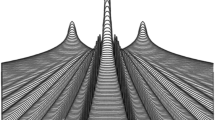Summary
A detailed mathematical treatment was carried out to determine the normalized wave functions of the hydrogen atom, according to the Feynman treatment of functional integrals, using the new «time» parameter. All calculations were performed in a system of parabolic co-ordinates, which is particularly well suited if the system comprising the hydrogen atom exhibits a privileged direction. A Lagrangian treatment was carried out, rather than using integrals in the phase space, in order to avoid ambiguities related to the Duru and Kleinert treatment. In addition, no global variable change was performed, but the co-ordinates were changed from Cartesian to parabolic in each short time interval, with a mid-point expansion. The propagator, expressed in parabolic co-ordinates was, then, decomposed into partial waves. Calculating the analytical expression of Green's function provided a means for determining the energy spectrum and the wave functions. Exposition of most intricate mathematical calculations was included.
Résumé
Nous proposons une étude et une analyse mathématique détaillée des solutions de l'atome d'hydrogène, dans le formalisme des intègrales fonctionelles de Feynman, utilisant le nouveau paramètre «temps». Les calculus sont tous rèalisés dans le système de coordonnées paraboliques, connu pour être particulièrement adapté si le système, comprenant l'atome d'hydrogène, présente une direction privilégiée. Nous utilisons un formalisme Lagrangien, plutôt que les intégrales dans l'espace des phases, pour éviter les ambiguités liées au formalisme de Duru et Kleinert. Par ailleurs, le changement de variables n'est pas réalisé globalement, mais à l'intérieur d'intervalles de temps très courts, avec développement au voisinage du milieu de l'intervalle. Le propagateur, exprimé en cordonnées paraboliques, est ensuite décomposé en ondes partielles. Nous donnons une expression analytique complète de la fonction de Green et en déduisons le spectre des énergies et les fonctions d'onde. Aucun des développements mathématiques les plus délicats, n'est escamoté.
Riassunto
Si stabilisce un formalismo matematico dettagliato per determinare le funzioni d'onda normalizzate dell'atomo di idrogeno, in base al formalismo di Feynman degli integrali funzionali, usando il nuovo parametro «tempo». Tutti i calcoli sono effettuati in un sistema di coordinate paraboliche, che è particolarmente appropriato se il sistema che comprende l'atomo di idrogeno presenta una direzione privilegiata. Si utilizza un formalismo lagrangiano, piuttosto che usare integrali nello spazio delle fasi, per evitare ambiguità legate al formalismo di Duru e Kleinert. Inoltre non si effettua globalmente il cambiamento di variabili, ma all'interno di intervalli molto corti si cambiano le coordinate da cartesiane a paraboliche con uno sviluppo nell'intorno del punto medio. Il propagatore, espresso in coordinate paraboliche è, quindi, scomposto in onde parziali. Calcolare l'espressione analitica della funzione di Green fornisce un nesso per determinare lo spettro d'energia e le funzioni d'onda. Si espongono anche i calcoli matematici piú intricati.
Резюме
Проводится подробный математический анализ решений для атома водороха, с помощью формализма функциональных интегралов Фейнмана, используя новый параметр: «время». Вычисления проводятся в системе параболических коордунат, специально приспособленных для изучения атома водорода. Используется Лагранжев формализм. Пропагатор определяется в параболических координатах, а затем разлагается по парциальным волнам. Приводится замкнутое аналитическое выражение для функции Грина и определяюгся спектры энергий и волновые функции. Предлагаются некоторые математические приложения.
Similar content being viewed by others
References
I. H. Duru andH. Kleinert:Phys. Lett. B,84, 185 (1979).
P. Kustaanheimo andE. Stieffel:J. Reine Angew. Math.,218, 204 (1965).
A. Inomata:Phys. Lett. A,87, 387 (1982).
N. K. Pak andI. Sokmen:Phys. Rev. A,30, 1629 (1984).
G. A. Ringwood andJ. T. Devreese:J. Math. Phys. (N. Y.) 21, 1390 (1980).
R. Ho andA. Inomata:Phys. Rev. Lett.,48, 231 (1982).
R. Feynman andA. Hibbs:Quantum Mechanics and Paths Integrals (McGraw-Hill, New York, N. Y., 1965).
D. McLaughlin andL. Schulman:J. Math. Phys. (N. Y.),12, 2520 (1971).
M. J. Lighthill:Introduction to Fourier Analysis and Generalized Functions (Cambridge University Press, Cambridge, 1964);J. S. Dowker:J. Phys. A,5, 936 (1972);J. M. Gracia-Bondia:Phys. Rev. A,30, 691 (1984).
E. Whittaker andG. Watson:A Course of Modern Analysis (Cambridge University Press, Cambridge, 1952);I. S. Gradshteyn andI. M. Ryzhik:Tables of Integrals, Series and Products (Academic Press, New York, N. Y., 1965).
I. H. Duru andM. Kleinert:Fortschr. Phys.,30, 401 (1982).
F. Steiner:Phys. Lett. A,106, 356, 363 (1984).
S. Flügge:Practical Quantum Mechanics I (Springer-Verlag, Berlin, Heidelberg, New York, N. Y., 1971);C. J. Joachaim:Quantum Collision Theory I (North-Holland, Amsterdam, Oxford, New York, N. Y., 1984).
Author information
Authors and Affiliations
Additional information
Traduzione a cura della Redazione.
Переведено ребакцией.
Rights and permissions
About this article
Cite this article
Chetouani, L., Hammann, T.F. Traitement exact des systèmes coulombiens, dans le formalisme des intégrales de Feynman, en coordonnées paraboliques. Nuov Cim B 98, 1–24 (1987). https://doi.org/10.1007/BF02721454
Received:
Published:
Issue Date:
DOI: https://doi.org/10.1007/BF02721454




